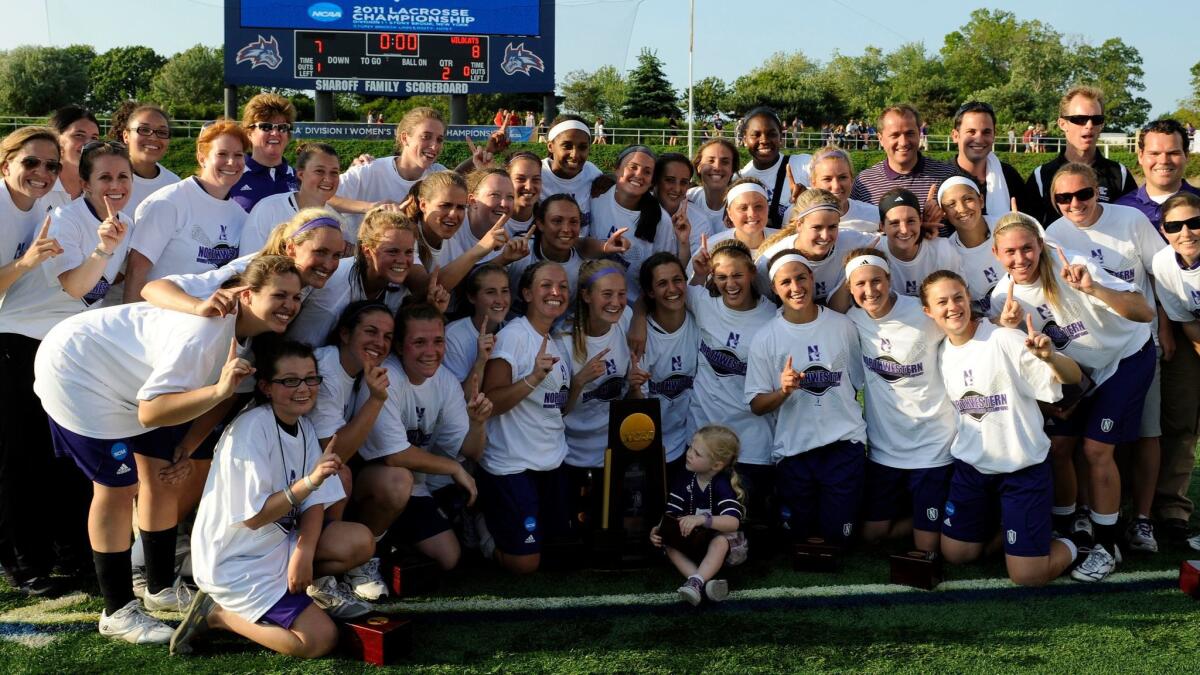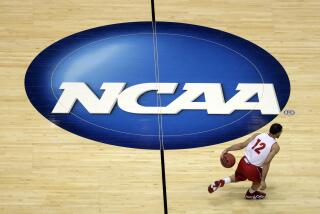Gonzaga isn’t college athletics’ only one-sport wonder

- Share via
They have popped up in the scablands of eastern Washington and along Lake Michigan. They have come to prominence during the Gilded Age and in the new Millennium.
They have all, at one point or another, shocked, dominated or captivated a sport.
What made college sports’ one-sport wonders what they are?
The typical formula for success dictates that a school build football and basketball into cash machines, with the revenue trickling down to the other sports programs. But often that isn’t practical.
Listed below are some examples of colleges best known for success in a single sport. It is not comprehensive — sorry Northern Arizona cross country — but does recognize teams that have achieved prominence under unlikely circumstances.
This is not a list of teams you are likely to see on television on Saturdays. Only one, Northwestern, fields a Division I football team.
So how did these schools do it?
The paths were different, but there were a few universal themes. Great coaching and stability at the position is essential. All the teams either had strong home-field advantages in recruiting or developed groundbreaking strategies to find or develop players. And, just as Cal State Fullerton built its baseball program well before interest in college baseball peaked, first movers and early investors — or at least overwhelmingly wealthy investors — were often able to build lasting advantages.
Gonzaga men’s basketball
America’s favorite Cinderella is actually the least decorated team on the list. But only because the degree of difficulty in college basketball is steep.
Gonzaga successfully parlayed a 1999 NCAA tournament run into 19 straight appearances, culminating in a loss in this year’s national championship game.
Since the emergence of Gonzaga basketball, the small, private university has seen applications swell and its coffers fattened by new donations.
Gonzaga is a story of coaching, recruiting and investment. Mark Few has coached his entire career, 18 years, at Gonzaga. He was a pioneer in the use of transfer players and international recruiting. And the school backed his winning program with the $25-million McCarthey Athletic Center, which has sold out every game since opening in 2004.
North Dakota men’s ice hockey
Ralph Engelstad Arena, North Dakota’s hockey venue that was completed in 2001, has been called the Taj Mahal of college hockey. It cost $104 million.
The floors are granite, from India. The seats are leather and the armrests cherry wood, from Valley Forge, Pa. And there is a chandelier, from Italy.
North Dakota’s success began before the late Ralph Engelstad, a former goalie and casino magnate, financed the arena. The school won seven national championships between 1959 and 2000, capitalizing on its access to hockey training grounds in the Upper Midwest and Canada. But the arena has given it a lasting competitive advantage at a school with a perpetually tight budget — the women’s team was abruptly discontinued in March.
The men’s team won a national championship in 2016 and produced a Hobey Baker Award winner, given to the best college hockey player in the nation, in 2007.
However, Engelstad’s donation came at a price. He was known to throw parties on Adolf Hitler’s birthday, and he seemed to go out of his way to insult the Sioux tribes, whose name North Dakota used to use as its nickname.
The school didn’t say no to his money, though.
Northwestern women’s lacrosse
Kelly Amonte Hiller went from being a club-team coach to one guiding an NCAA national champion in four years, and then on to become the architect of the most dominant team the sport had ever seen.
Northwestern won five consecutive titles from 2005 to 2009, when its record was a combined 106-3, then two more in 2011 and 2012.
Its 2009 team won by an average of 11.5 goals per game.
The Chicago area isn’t a lacrosse hotbed, but Hiller changed the game by finding superior athletes and teaching them to play. She once happened upon two sisters playing intramural football and invited them to try out. They became All-Americans.
Northwestern players have won five Tewaaraton Awards, the sport’s equivalent of the Heisman Trophy.
In its other sports, Northwestern has won just one national championship: fencing, in 1941.
Johns Hopkins men’s lacrosse
Here is a testament to the value of showing up early: Johns Hopkins started playing lacrosse in 1883, long enough, it turns out, to become a signature part of the school’s identity, up there with its hospital. And the school protects one of its most powerful marketers with special status: The men’s and women’s lacrosse teams are the only Division I programs at the school.
The men’s team joined the powerful Big Ten Conference for lacrosse only. That’s what happens when you’ve won nine NCAA titles — and another 35 championships prior to the NCAA era.
Follow Zach Helfand on Twitter @zhelfand
More to Read
Go beyond the scoreboard
Get the latest on L.A.'s teams in the daily Sports Report newsletter.
You may occasionally receive promotional content from the Los Angeles Times.











